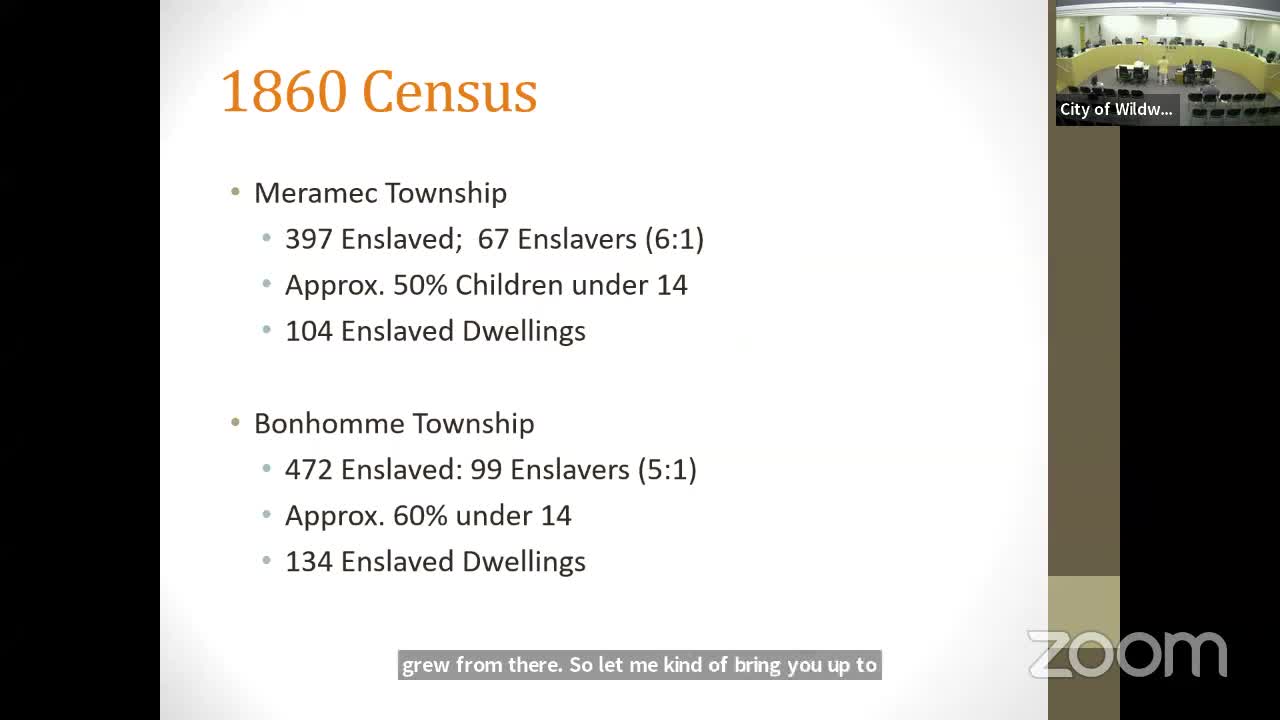Uncovering the Hidden History of Enslaved Lives
August 22, 2024 | Wildwood, St. Louis County, Missouri
This article was created by AI summarizing key points discussed. AI makes mistakes, so for full details and context, please refer to the video of the full meeting. Please report any errors so we can fix them. Report an error »

A recent government meeting highlighted the historical presence of enslaved individuals in the Wildwood area, specifically within Merrimack and Bonham Townships, as documented in the 1860 census. The census revealed a significant population of 397 enslaved people living in the area, alongside 67 enslaver families, indicating a ratio of approximately six enslaved individuals for every enslaver household.
The discussion emphasized the importance of understanding the demographics of enslaved populations, noting that children under the age of 14 comprised about 50% of the enslaved population in Merrimack Township and 60% in Bonham Township. This demographic detail underscores the impact of slavery on families and the community at large.
The census data, which included a unique \"slave schedule,\" provided insights into the living conditions of enslaved individuals. It recorded not only the number of enslaved people but also the number of enslaved dwellings, with 104 in Merrimack Township and 134 in Bonham Township. Notably, prominent enslaver families, such as the Colemans and the Tylers, maintained multiple dwellings for their enslaved workers, reflecting the scale of their operations.
The meeting also touched on the broader implications of slavery in Missouri, where the institution was most prevalent along the Missouri River. It was noted that while the importation of enslaved individuals had ceased, the practice of breeding enslaved children for sale became a grim reality, particularly in the southern states.
This discussion serves as a crucial reminder of the historical context of slavery in the region and its lasting impact on the community. The meeting concluded with an invitation for questions, encouraging further exploration of this significant aspect of local history.
The discussion emphasized the importance of understanding the demographics of enslaved populations, noting that children under the age of 14 comprised about 50% of the enslaved population in Merrimack Township and 60% in Bonham Township. This demographic detail underscores the impact of slavery on families and the community at large.
The census data, which included a unique \"slave schedule,\" provided insights into the living conditions of enslaved individuals. It recorded not only the number of enslaved people but also the number of enslaved dwellings, with 104 in Merrimack Township and 134 in Bonham Township. Notably, prominent enslaver families, such as the Colemans and the Tylers, maintained multiple dwellings for their enslaved workers, reflecting the scale of their operations.
The meeting also touched on the broader implications of slavery in Missouri, where the institution was most prevalent along the Missouri River. It was noted that while the importation of enslaved individuals had ceased, the practice of breeding enslaved children for sale became a grim reality, particularly in the southern states.
This discussion serves as a crucial reminder of the historical context of slavery in the region and its lasting impact on the community. The meeting concluded with an invitation for questions, encouraging further exploration of this significant aspect of local history.
View full meeting
This article is based on a recent meeting—watch the full video and explore the complete transcript for deeper insights into the discussion.
View full meeting
